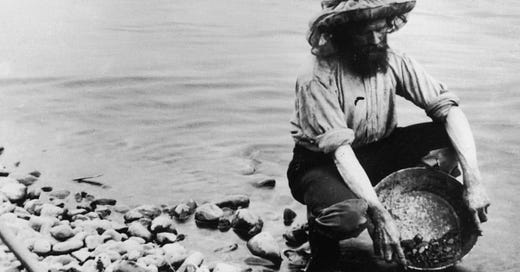#ThisDayInHistory The Klondike Gold Rush Began
On this day in 1896 while salmon fishing near the Klondike River in Canada’s Yukon Territory on August 16, 1896, George Carmack reportedly spots nuggets of gold in a creek bed.
His lucky discovery sparks the last great gold rush in the American West.
Gold was present along the river in huge quantities. Carmack measured out four claims, strips of ground that could later be legally mined by the owner, along the river; these including two for himself—one as his normal claim, the second as a reward for having discovered the gold—and one each for Jim and Charlie.
The claims were registered the next day at the police post at the mouth of the Fortymile River and news spread rapidly from there to other mining camps in the Yukon River valley.
Despite the winter, many prospectors immediately left for the Klondike by dog-sled, eager to reach the region before the best claims were taken. The outside world was still largely unaware of the news and although Canadian officials had managed to send a message to their superiors in Ottawa about the finds and influx of prospectors, the government did not give it much attention.
The winter prevented river traffic, and it was not until June 1897 that the first boats left the area, carrying the freshly mined gold and the full story of the discoveries.
Geologically, the region was permeated with veins of gold, forced to the surface by volcanic action and then worn away by the action of rivers and streams, leaving nuggets and gold dust in deposits known as placer gold.
In the resulting Klondike stampede, an estimated 100,000 people tried to reach the Klondike goldfields, of whom only around 30,000 to 40,000 eventually did. It formed the height of the Klondike gold rush from the summer of 1897 until the summer of 1898.
The prospectors came from many nations, although an estimated majority of 60 to 80 percent were Americans or recent immigrants to America. Most had no experience in the mining industry, being clerks or salesmen. Mass resignations of staff to join the gold rush became notorious. In Seattle, this included the mayor, twelve policemen, and a significant percentage of the city's streetcar drivers.
It began on July 15, 1897, in San Francisco and was spurred further two days later in Seattle, when the first of the early prospectors returned from the Klondike, bringing with them large amounts of gold on the ships Excelsior and Portland. The press reported that a total of $1,139,000 (equivalent to $1 billion at 2010 prices) had been brought in by these ships, although this proved to be an underestimate.
Economically, the news had reached the US at the height of a series of financial recessions and bank failures in the 1890s. The gold standard of the time tied paper money to the production of gold and shortages towards the end of the 19th century meant that gold dollars were rapidly increasing in value ahead of paper currencies and being hoarded.
This contributed to the Panic of 1893 and Panic of 1896, which caused unemployment and financial uncertainty. There was a huge, unresolved demand for gold across the developed world that the Klondike promised to fulfill, and, for individuals, the region promised higher wages or financial security.
Seattle and San Francisco competed fiercely for business during the rush, with Seattle winning the larger share of trade.
Of the estimated 30,000 to 40,000 people who reached Dawson City during the gold rush, only around 15,000 to 20,000 finally became prospectors. Of these, no more than 4,000 struck gold and only a few hundred became rich.
#ThisDayInHistory
August 16, 1896





